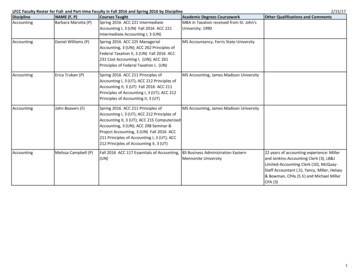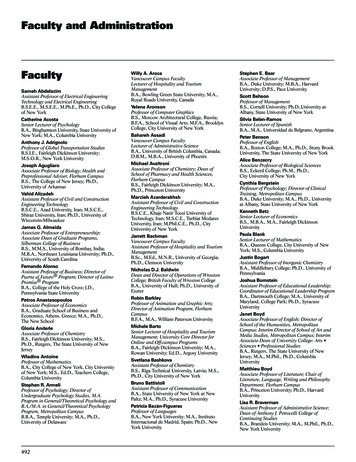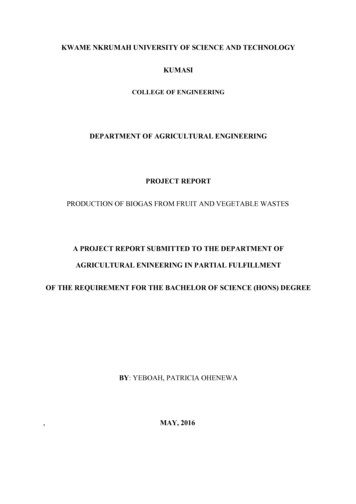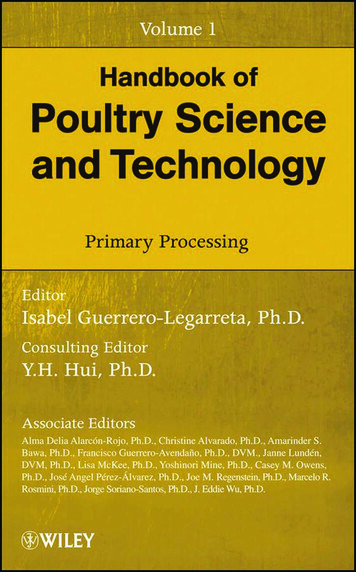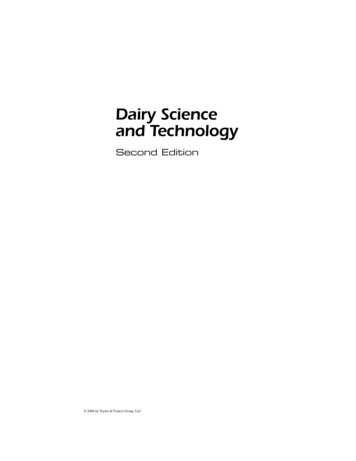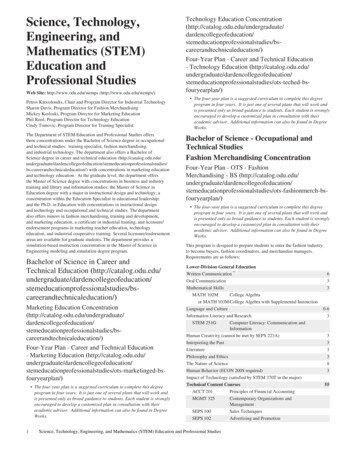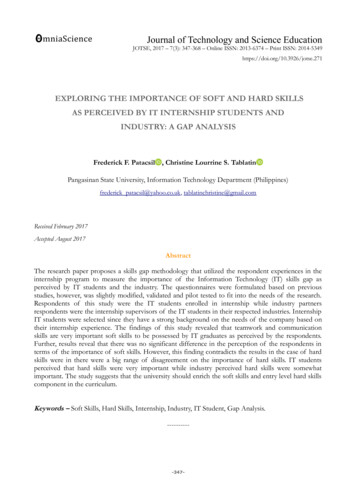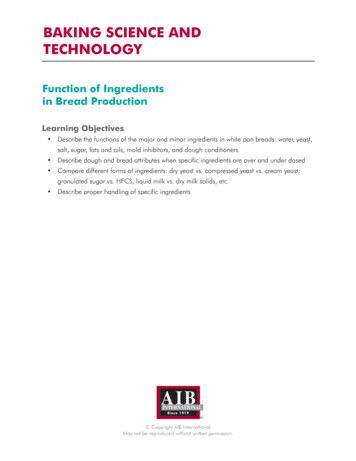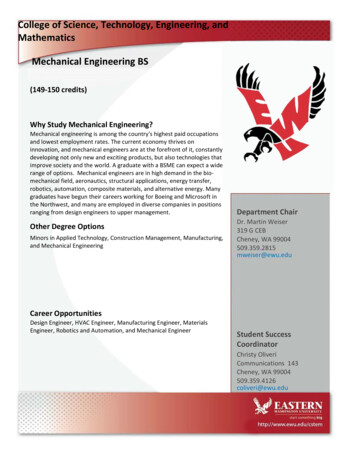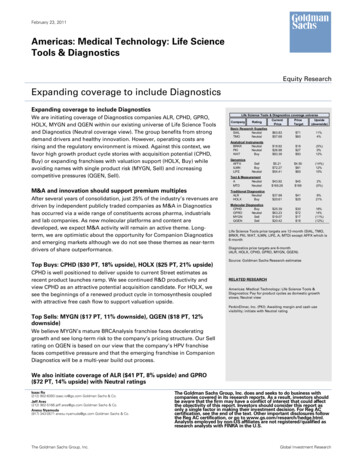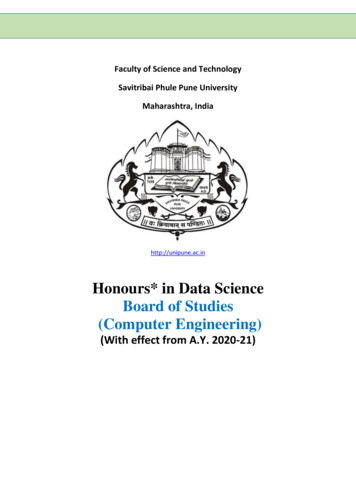
Transcription
Faculty of Science and TechnologySavitribai Phule Pune UniversityMaharashtra, Indiahttp://unipune.ac.inHonours* in Data ScienceBoard of Studies(Computer Engineering)(With effect from A.Y. 2020-21)
Savitribai Phule Pune UniversityHonours* in Data ScienceWith effect from 2020-21Term workPracticalPresentationTotal Marks30 -15004010504 ----30 70------10004--0404--100---10004-0404 ----30 -150040105ArtificialIntelligence for BigData Analytics04---30 70------10004--04Seminar-- 02-------50 5002--020402---50 15006-0605Statistics andMachine LearningTotalTotal Credits 04BE 410501Machine&Learning andVIIData Science410502Machine Learningand Data ScienceLaboratoryTotalTotalCredits BE 410503&VIII410504Credits --05TotalTotal--Total CreditEnd-Semester--Data Science andVisualizationData Science andVisualizationLaboratoryTotalTheory /TutorialPracticalMid-SemesterTE 310503&VICredit SchemePracticalCredits Examination Schemeand Marks04 --TheoryTE 310501&V 310502TotalTeachingSchemeHours /WeekTutorialYear & SemesterCourse Code andCourse Title---10006Total Credit for Semester V VI VII VIII 20* To be offered as Honours for Major Disciplines as–1. Computer Engineering2. Electronics and Telecommunication Engineering3. Electronics Engineering4. Information TechnologyFor any other Major Disciplines which is not mentioned above, it may be offered as Minor Degree.Reference: H%202020 21.pdf/ page 99-100
Savitribai Phule Pune UniversityHonours* in Data ScienceThird Year of Engineering (Semester V)310501: Data Science and VisualizationTeaching SchemeCredit SchemeExamination Scheme and MarksLecture: 04 Hours/Week04Mid Semester(TH): 30 MarksEnd Semester(TH): 70 MarksPrerequisites: Computer graphics, Database management systemCompanion Course:---Course Objectives:1. To learn data collection and preprocessing techniques for data science2. To Understand and practice analytical methods for solving real life problems.3. To study data exploration techniques4. To learn different types of data and its visualization5. To study different data visualization techniques and tools6. To map element of visualization well to perceive informationCourse Outcomes:On completion of the course, learner will be able to–CO1: Apply data preprocessing methods on open access data and generate quality data foranalysisCO2: Apply and analyze classification and regression data analytical methods for real lifeProblems.CO3: Implement analytical methods using Python/RCO4: Apply different data visualization techniques to understand the data.CO5: Analyze the data using suitable method; visualize using the open source tool.CO6: Model Multi dimensional data and visualize it using appropriate toolCourse ContentsUnit IIntroduction to Data Science(06 Hours)Defining data science and big data, Recognizing the different types of data, Gaining insight into the datascience process, Data Science Process: Overview, Different steps, Machine Learning Definition and Relationwith Data ScienceUnit IIStatistics and Probability basics for Data(07 Hours)AnalysisStatistics: Describing a Single Set of Data, Correlation, Simpson’s Paradox, Some Other CorrelationalCaveats, Correlation and CausationProbability : Dependence and Independence, Conditional Probability, Bayes’s Theorem, RandomVariables, Continuous Distributions, The Normal Distribution, The Central Limit TheoremUnit IIIData Analysis in depth(07 Hours)Data Analysis Theory and Methods: Clustering –Overview, K-means- overview of method,determining number of clusters, Association Rules- Overview of method, Apriori algorithm,evaluation of association rules, Regression-Overview of linear regression method, model description.Classification- Overview, Naïve Bayes classifierUnit IVAdvanced Data Analysis Means(07 Hours)Decision Trees: What Is a Decision Tree? Entropy, The Entropy of a Partition, Creating a Decision Tree,Random ForestsNeural Networks : Perceptrons, Feed-Forward Neural Networks, Backpropagation, Example:Defeating a CAPTCHAMapReduce : Why MapReduce? Examples like word count and matrix multiplicationUnit VBasics of Data Visualization(07 Hours)
Introduction to data visualization, challenges of data visualization, Definition of Dashboard, Theirtype, Evolution of dashboard, dashboard design and principles, display media for dashboard.Types of Data visualization: Basic charts scatter plots, Histogram,advanced visualization Techniqueslike streamline and statistical measures, Plots, Graphs, Networks, Hierarchies, Reports.Unit VIData visualization of multidimensional(07 Hours)dataNeed of data modeling, Multidimensional data models, Mapping of high dimensional data intosuitable visualization method- Principal component analysis, clustering study of High dimensionaldata.Learning ResourcesText Books:Data Mining: Concepts and Techniques, 3rd Edition. Jiawei Han, Micheline Kamber, Jian Pei.Data Science from Scratch : Joel Grus, O’Reilly Media Inc., ISBN: 9781491901427Information visualization perception for design, colin ware, MK publicationReference Books:Big data black book, Dream tech publicationGetting Started with Business Analytics: Insightful Decision-Making , David Roi Hardoon,GalitShmueli, CRC PressBusiness Analytics , James R Evans, PearsonPython Data science Handbook, Jake VanderPlas, Orielly publicationData Science for Business: What You Need to Know about Data Mining and Data-AnalyticThinking, Vovost Foster, Fawcett Tome-Books:handbook for visualizing : a handbook for data driven design by Andy ogrammer-books.com/introducing-data-science-pdf/An Introduction to Statistical Learning with Applications in MOOC/ Video Lectures available at: https://nptel.ac.in/courses/106/106/106106179/ https://nptel.ac.in/courses/106/106/106106212/ https://nptel.ac.in/courses/106/105/106105174/
Savitribai Phule Pune UniversityHonours* in Data ScienceThird year of Engineering (Semester V)310502: Data Science and Visualization LaboratoryTeaching SchemeCredit SchemePracticall: 01 Hours/Week01 Examination Scheme and MarksTerm work:50 MarksGuidelines for Laboratory ConductionLab Assignments: Following is list of suggested laboratory assignments for reference. LaboratoryInstructors may design suitable set of assignments for respective course at their level. Beyondcurriculum assignments and mini-project may be included as a part of laboratory work. Theinstructor may set multiple sets of assignments and distribute among batches of students. It isappreciated if the assignments are based on real world problems/applications. The Inclusion offew optional assignments that are intricate and/or beyond the scope of curriculum will surely bethe value addition for the students and it will satisfy the intellectuals within the group of thelearners and will add to the perspective of the learners. For each laboratory assignment, it isessential for students to draw/write/generate flowchart, algorithm, test cases, mathematical model,Test data set and comparative/complexity analysis (as applicable). Batch size for practical andtutorial may be as per guidelines of authority.Term Work–Term work is continuous assessment that evaluates a student's progress throughoutthe semester. Term work assessment criteria specify the standards that must be met and theevidence that will be gathered to demonstrate the achievement of course outcomes. Categoricalassessment criteria for the term work should establish unambiguous standards of achievementfor each course outcome. They should describe what the learner is expected to perform in thelaboratories or on the fields to show that the course outcomes have been achieved. It isrecommended to conduct internal monthly practical examination as part of continuousassessment.Assessment: Students’ work will be evaluated typically based on the criteria like attentiveness,proficiency in execution of the task, regularity, punctuality, use of referencing, accuracy oflanguage, use of supporting evidence in drawing conclusions, quality of critical thinking andsimilar performance measuring criteria.Laboratory Journal- Program codes with sample output of all performed assignments are to besubmitted as softcopy. Use of DVD or similar media containing students programs maintained byLaboratory In-charge is highly encouraged. For reference one or two journals may be maintainedwith program prints in the Laboratory. As a conscious effort and little contribution towards GreenIT and environment awareness, attaching printed papers as part of write-ups and program listingto journal may be avoided. Submission of journal/ term work in the form of softcopy is desirableand appreciated.Suggested List of AssignmentsSr. NoName of assignment1Access an open source dataset “Titanic”.Apply pre-processing techniques on the raw dataset.2Build training and testing dataset of assignment 1 to predict the probability of a survival of aperson based on gender, age and passenger-class.Download Abalone dataset. (URL: a set has total 8 Number of Attributes.Sex nominal M, F, and I (infant)Lengthcontinuousmm Longest shell measurementDiametercontinuousmm perpendicular to length3
4Heightcontinuousmm with meat in shellWhole weight continuousgrams whole abaloneShucked weightcontinuousgrams weight of meatViscera weightcontinuousgrams gut weight (after bleeding)Shell weight continuousgrams after being driedRings (age/class of abalone)Load the data from data file and split it into training and test datasets. Summarizethe properties in the training dataset. The number of rings is the value to predict:either as a continuous value or as a classification problem.Predict the age of abalone from physical measurements using linear regression orpredict ring class as classification problemUse Netflix Movies and TV Shows dataset from Kaggle and perform followingoperation :1. Make a visualization showing the total number of movies watched bychildren2. Make a visualization showing the total number of standup comedies3. Make a visualization showing most watched shows.4. Make a visualization showing highest rated showMake a dashboard (DASHBOARD A) containing all of these above visualizations.
Savitribai Phule Pune UniversityHonours* in Data ScienceThird Year of Engineering (Semester VI)310503: Statistics and Machine LearningTeaching SchemeCredit SchemeLecture: 04 Hours/Week04Examination Scheme and MarksMid Semester(TH): 30 MarksEnd Semester(TH): 70 MarksPrerequisites: Date Science and VisualizationCompanion Course :Machine learningCourse Objectives:1. To understand basis of statistics and mathematics for Machine Learning2.To understand basis of descriptive statistics measures and hypothesis3.To learn various statistical inference methods4. To introduce basic concepts and techniques of Machine Learning5. To learn different linear regression methods used in machine learning6. To learn Classification models used in machine learningCourse Outcomes:On completion of the course, learner will be able to–CO1: Apply appropriate statistical measure for machine learning applicationsC02: Usage of appropriate descriptive statistics measures for statistical analysisC03: Usage of appropriate statistics inference for data analysisCO4: Identify types of suitable machine learning techniquesCO5: Apply regression techniques to machine learning problemsCO6: Apply decision tree and Naïve Bayes model to solve real time applicationsCourse ContentsUnit IStatistical Inference I(07 Hours)Types of Statistical Inference, Descriptive Statistics, Inferential Statistics, Importance of StatisticalInference in Machine Learning. Descriptive Statistics, Measures of Central Tendency: Mean, Median,Mode, Mid-range, Measures of Dispersion: Range, Variance, Mean Deviation, Standard Deviation.One sample hypothesis testing, Hypothesis, Testing of Hypothesis, Chi-Square Tests, t-test, ANOVAand ANOCOVA. Pearson Correlation, Bi-variate regression, Multi-variate regression, Chi-squarestatistics.#Exemplar/CaseStudiesUnit IIFor a payroll dataset create Measure of central tenancy and its measure ofdispersion for statistical analysis of given data.Statistical Inference II(07 Hours)Measure of Relationship: Covariance, Karl Pearson’s Coefficient of Correlation, Measures of Position:Percentile, Z-score, Quartiles, Bayes’ Theorem, Bayes Classifier, Bayesian network, Discriminativelearning with maximum likelihood, Probabilistic models with hidden variables, Linear models,regression analysis, least squares.#Exemplar/CaseStudiesUnit IIICreate a probabilistic model for credit card fraud detectionLinear Algebra and Calculus(07 Hours)Linear Algebra: Matrix and vector algebra, systems of linear equations using matrices, linearindependence, Matrix factorization concept/LU decomposition, Eigen values and eigenvectors.Understanding of calculus: concept of function and derivative, Multivariate calculus: concept, PartialDerivatives, chain rule, the Jacobian and the Hessian
#Exemplar/CaseStudiesUnit IVExplore statistical inference for Financial Statement Fraud DetectionIntroduction to machine learning(07 Hours)What is Machine Learning? Well posed learning problems, Designing a Learning system,MachineLearning types-Supervised learning, Unsupervised learning, and Reinforcement Learning, Applicationsof machine learning, Perspective and Issues in Machine Learning#Exemplar/CaseStudiesUnit VExplore use of machine learning in NETFLIX as case studyRegression Model(07 Hours)Introduction, types of regression. Simple regression- Types, Making predictions, Cost function,Gradient descent, Training, Model evaluation.Multivariable regression : Growing complexity, Normalization, Making predictions, Initialize weights,Cost function, Gradient descent, Simplifying with matrices, Bias term, Model evaluation#Exemplar/CaseStudiesUnit VIMachine Learning for Health Data Analytics: A Few Case Studies ofApplication of Regression Machine Learning for Health Data Analytics byIyyanki Murali krishna ,Prisilla Jayanthi and Valli ManickamClassification Models(08 Hours)Decision tree representation, Constructing Decision Trees, Classification and Regression Trees,hypothesis space search in decision tree learningBayes' Theorem, Working of Naïve Bayes' Classifier, Types of Naïve Bayes Model, Advantages,Disadvantages and Application of Naïve Bayes Model#Exemplar/CaseExplore decision tree model for customer churnsStudiesLearning ResourcesText Books:1. Tom M. Mitchell, Machine Learning, India Edition 2013, McGraw Hill Education.2. S.P. Gupta, Statistical Methods, Sultan Chand and Sons, New Delhi, 2009,3. Kothari C.R., “Research Methodology. New Age International, 2004, 2nd Ed; ISBN:13: 97881-224-1522-3.Reference Books:1. Peter Harrington, Machine Learning In Action, DreamTech Press 2.ISBN: 97816172901832. Alpaydin, Ethem. Machine learning: the new AI. MIT press, 2016, ISBN: 97802625295183. Stephen Marsland, Machine Learning An Algorithmic Perspective, CRC Press, ISBN: :978-1-4665-8333-7e-Books/ Articles:1. Johan Perols (2011) Financial Statement Fraud Detection: An Analysis of Statistical andMachine Learning Algorithms. AUDITING: A Journal of Practice & Theory: May 2011,Vol. 30, No. 2, pp. 19-50.2. Panigrahi, Suvasini, et al. "Credit card fraud detection: A fusion approach usingDempster–Shafer theory and Bayesian learning." Information Fusion 10.4 (2009): 354363.MOOC/ Video Lectures available at: https://nptel.ac.in/courses/106/106/106106139/ https://nptel.ac.in/courses/106/105/106105152/
Savitribai Phule Pune UniversityHonours* in Data ScienceFourth year of Engineering (Semester VII)410501: Machine learning and Data ScienceTeaching SchemeCredit SchemeLecture: 04 Hours/Week04Examination Scheme and MarksMid Semester(TH): 30 MarksEnd Semester(TH): 70 MarksPrerequisites: Data Science and Visualization, Statistic and Machine LearningCompanion Course:Machine learningCourse Objectives:1. To understand and learn regression models, interpret estimates and diagnostic statistics2. To understand and learn different classification models and its algorithms3. To understand and learn clustering methods4. To generate an ability to build neural networks for solving real life problems.5. To acquire knowledge of Convolution Artificial Neural Networks , Recurrent network6. To apply analytics concept on text dataCourse Outcomes:On completion of the course, learner will be able to–1.2.3.4.Apply, build and fit regression models for real time problems.Apply and build classification models using SVM and random forest classifiers.Apply and build clustering models using clustering methods and its corresponding algorithms.Design and development of certain scientific and commercial application using computationalneural network models,5. Apply text classification and topic modelling methods to solve given problemUnit ICourse ContentsRegression Models(07 Hours)Overview of statistical linear models, residuals, regression inference, Generalized linear models,logistic regression, Interpretation of odds and odds ratios, Maximum likelihood estimation in logisticregression, Poisson regression, Examples, Interpreting logistic regression, Visualizing fitting logisticregression curves.#Exemplar/CaseRemote sensing and GIS-based landslide hazard analysis and cross-validationStudiesusing multivariate logistic regression modelUnit IIClassification Methods(07 Hours)Support Vector Machine classification algorithm, hyper plane, optimal separating hyperplanes , kernelfunctions, kernel selection, applications, Introduction to ensemble and its techniques, Bagging andBootstrap ensemble methods, Introduction to random forest, growing of random forest, random featureselection#Exemplar/CaseFace recognition using SVM Or Product review case study in area ofStudiessentimental analysis using SVM and random forest classifiersUnit IIIClustering Methods(07 Hours)Overview of clustering and unsupervised learning, Introduction to clustering methods :Partitioningmethods K-Means algorithm, assessing quality and choose number of clusters, KNN (1 NN, K NN)techniques, K-Medians, Density based method: Density-Based Spatial Clustering. Hierarchicalclustering methods: Agglomerative Hierarchical clustering technique, Roles of dendrograms andChoosing number clusters in Hierarchical clustering, Divisive clustering techniques.#Exemplar/CaseStudiesCase study on DNA sequencing and hierarchical clustering to find thephylogenetic tree of animal evolution
Unit IVArtificial Neural Network(07 Hours)Biological neuron, models of a neuron, Introduction to Neural networks, network architectures (feedforward, feedback etc.), Activation FunctionsPerceptron, Training a Perceptron, Multilayer Perceptrons, Back propagation Algorithm, GeneralizedDelta Learning Rule, Limitations of MLP#Exemplar/CaseStudiesUnit VCharacter reorganization using neural networkConvolutional Neural Network(07 Hours)Convolutional Neural Network, Recursive Neural Network, Recurrent Neural Network, Long-shortTerm Memory, Gradient descent optimization#Exemplar/CaseEdge recognition using CNNStudiesUnit VIApplications Perspective(07 Hours)Text Preprocessing- tokenization, document representation, feature selection, feature extraction;Topic modeling algorithms-Latent Dirichlet Allocation;Text Similarity measure#Exemplar/CaseSMS classificationStudiesLearning ResourcesText Books:1. Machine Learning by Tom M. Mitchell2. Douglas Montgomery, Elizabeth A. Peck, and G. Geoffrey Vining, “Introduction to LinearRegression Analysis”, 5th edition, Wiley publication.3. Data Clustering Algorithms and Applications By Charu C. Aggarwal, Chandan K. Reddy4. EthemAlpaydin: Introduction to Machine Learning, PHI 2nd Edition-2013Reference Books:1. Hands-On Machine Learning with Scikit-Learn, Keras, and TensorFlow: Concepts, Tools, andTechniques to Build Intelligent Systems 2nd Edition2. B Yegnanarayana : Artificial Neural Networks for pattern recognition ,PHI Learning Pvt.Ltd., 14-Jan-20093. Jack Zurada: Introduction to Artificial Neural Systems, PWS Publishing Co. Boston, 2002.4. Feldman, Ronen, and James Sanger, eds. The text mining handbook: advanced approaches inanalyzing unstructured data. Cambridge University Press, 2007.e-Books:1. l-systems-wpc-1992.pdf2. https://www.academia.edu/35741465/Introduction to Machine Learning 2e EthemAlpaydin3. Support Vector Machines for Classification and Regression by Steve R. /02/svm gunn1.pdf)MOOC/ Video Lectures available at: s://nptel.ac.in/courses/106/106/106106184/
Savitribai Phule Pune UniversityHonours* in Data ScienceFourth year of Engineering (Semester VII)410502: Machine learning and Data Science LaboratoryTeaching SchemeCredit SchemeExamination Scheme and MarksPractical: 01 Hours/Week Term work: 50 MarksGuidelines for Laboratory ConductionLab Assignments: Following is list of suggested laboratory assignments for reference. LaboratoryInstructors may design suitable set of assignments for respective course at their level. Beyondcurriculum assignments and mini-project may be included as a part of laboratory work. Theinstructor may set multiple sets of assignments and distribute among batches of students. It isappreciated if the assignments are based on real world problems/applications. The Inclusion offew optional assignments that are intricate and/or beyond the scope of curriculum will surely bethe value addition for the students and it will satisfy the intellectuals within the group of thelearners and will add to the perspective of the learners. For each laboratory assignment, it isessential for students to draw/write/generate flowchart, algorithm, test cases, mathematical model,Test data set and comparative/complexity analysis (as applicable). Batch size for practical andtutorial may be as per guidelines of authority.Term Work–Term work is continuous assessment that evaluates a student's progress throughoutthe semester. Term work assessment criteria specify the standards that must be met and theevidence that will be gathered to demonstrate the achievement of course outcomes. Categoricalassessment criteria for the term work should establish unambiguous standards of achievementfor each course outcome. They should describe what the learner is expected to perform in thelaboratories or on the fields to show that the course outcomes have been achieved. It isrecommended to conduct internal monthly practical examination as part of continuousassessment.Assessment: Students’ work will be evaluated typically based on the criteria like attentiveness,proficiency in execution of the task, regularity, punctuality, use of referencing, accuracy oflanguage, use of supporting evidence in drawing conclusions, quality of critical thinking andsimilar performance measuring criteria.Laboratory Journal- Program codes with sample output of all performed assignments are to besubmitted as softcopy. Use of DVD or similar media containing students programs maintained byLaboratory In-charge is highly encouraged. For reference one or two journals may be maintainedwith program prints in the Laboratory. As a conscious effort and little contribution towards GreenIT and environment awareness, attaching printed papers as part of write-ups and program listingto journal may be avoided. Submission of journal/ term work in the form of softcopy is desirableand appreciated.Suggested List of AssignmentsSr. No101Name of assignment2Creating & Visualizing Neural Network for the given data. (Use python)Note: download dataset using Kaggal. Keras, ANN visualizer, graph viz libraries areequired.Recognize optical character using ANN3Implement basic logic gates using Hebbnet neural networks5Exploratory analysis on Twitter text dataPerform text pre-processing, Apply Zips and heaps law, Identify topicsText classification for Sentimental analysis using KNNNote: Use twitter dataWrite a program to recognize a document is positive or negative based on polaritywords using suitable classification method.46
Savitribai Phule Pune UniversityHonours* in Data ScienceFourth year of Engineering (Semester VIII)410503: Artificial Intelligence for Big Data MiningTeaching SchemeCredit SchemeExamination Scheme and MarksLecture: 04 Hours/Week04Mid Semester(TH): 30 MarksEnd Semester(TH): 70 MarksPrerequisites: Data science fundamentals and statistical learningCompanion Course:Artificial Intelligence, Data AnalyticsCourse Objectives:1.2.3.4.5.To learn artificial intelligence techniquesTo Understand big data learning methodsTo study deep learning techniquesTo learn Hadoop ecosystem and its componentsTo learn the implementation of Data analysis using Hadoop6. To study the concept and methods of natural language processing, fuzzy system, andreinforcement learningCourse Outcomes:On completion of the course, learner will be able to–CO1: Apply basic artificial learning method for big data analysisCO2: Apply and analyze learning methods for big dataCO3: Implement data analytics using HadoopCO4: Apply neural networks on big data and analyze the performance.CO5: Implement and Analyze scalable machine learning using HadoopCO6: Apply NLP, Reinforcement learning and fuzzy logic on Big dataCourse ContentsUnit IIntroduction to Artificial Intelligence(07 Hours)Need of AI, Applications of AI, Logic programming-solving problems using logic programming, Heuristicsearch techniques- constraint satisfaction problems, local search techniques, greedy search#Exemplar/Case Studies*Mapping of CourseOutcomes for Unit IUnit IIInstall easy AI library and explore various functionalitiesInstall Python packages for logic programmingCO1Big Data Learning(07 Hours)Introduction to Big Data, Characteristics of big data, types of data, Supervised and unsupervisedmachine learning, Overview of regression analysis, clustering, data dimensionality, clustering methods,Introduction to Spark programming model and MLib library, Content based recommendation systems.#Exemplar/Case StudiesMarket based shopping pattern*Mapping of CourseOutcomes for Unit IIUnit IIICO2Neural networks for big data(07 Hours)Fundamental of Neural networks and artificial neural networks, perceptron and linear models,nonlinearities model, feed forward neural networks, Gradient descent and backpropagation,Overfitting, Recurrent neural networks
#Exemplar/Case StudiesExplore PyTorch library for Neural networks*Mapping of CourseOutcomes for Unit IIICO4Unit IVBig data analytics using Hadoop-I(07 Hours)Hadoop Ecosystem, HDFS, Map Reduce, Python And Hadoop streaming, Spark- basics, Pyspark#Exemplar/Case Studies*Mapping of CourseOutcomes for Unit IVUnit VInstall HadoopCO3Big data analytics using Hadoop-II(07 Hours)Data warehousing and mining, Data analysis using Hive, Data ingestion, Scalable machine learningusing Spark.#Exemplar/Case StudiesInstall Hadoop ecosystem products – Sqoop, Hive, HBase*Mapping of CourseOutcomes for Unit VUnit VICO5Applications(07 Hours)NLP: Natural language processing steps: Text pre-processing, feature extraction, applying NLPtechniques. Applications: sentiment analysisComputer Vision: General steps image pre-processing, feature extraction, applying machine learningalgorithms. Applications: object detection#Exemplar/Case StudiesRobotics, text summarization*Mapping of CourseOutcomes for Unit VICO6Learning ResourcesText Books:1. Anand Deshpande, Manish Kumar ,Artificial intelligence for Big data, Packt publication, ISBN97817884721732. Benjamin Bengfort, Jenny Kim,Data Analytics with Hadoop, O'Reilly Media, Inc., ISBN:9781491913703Reference Books:1. Artificial Intelligence with Python, Prateek Joshi, Packt Publication, ISBN:97817864643922. Big data black book, Dream tech publication, ISBN 97893511975773. Bill Chambers, Matei Zaharia,Spark: The Definitive Guide, O'Reilly Media, Inc.ISBN:97814919122184. Tom White ,Hadoop: The Definitive Guide, 4th Edition, Publisher: O'Reilly Media, Inc., ISBN:9781491901687e-Books:1. 636920028307/Big Data Now 2012 Edition.pdfMOOC/ Video Lectures available at: /swayam.gov.in/nd1 noc19 6102220/
Savitribai Phule Pune UniversityHonours* in Data ScienceFourth Year of Engineering (Semester VII)410504: SeminarTeaching SchemeCredit SchemeExamination Scheme and MarksPractical: 02Hours/Week02Presentation: 50 MarksCourse Objectives: To train the student to independently search, identify and study important topics incomputer science. To develop skills among students to study and keep themselves up to date of thetechnological developments taking place in computer science To expose students to the world of research, technology and innovation.Course Outcomes:On completion of the course, student will be able to To train the student to independently search, identify and study important topics incomputer science. To develop skills among students to study and keep themselves up to date of thetechnological developments taking place in computer science. To expose students to the world of research, technology and innovationGuidelines for Seminar: The department will assign an internal guide under which students shall carry out Hons.seminar work In order to select a topic for Hons. Seminar, the student shall refer to various resources likebooks, magazines, scientific papers, journals, the Internet and experts from industries andresearch institutes The topic selected for Hons. Seminar by the students will be scrutinized and if foundsuitable, shall be approved by the interna
Data Mining: Concepts and Techniques, 3rd Edition. Jiawei Han, Micheline Kamber, Jian Pei. Data Science from Scratch : Joel Grus, O’Reilly Media Inc., ISBN: 9781491901427 Information visualization perception for design, colin ware, MK publication Reference Books: Big
